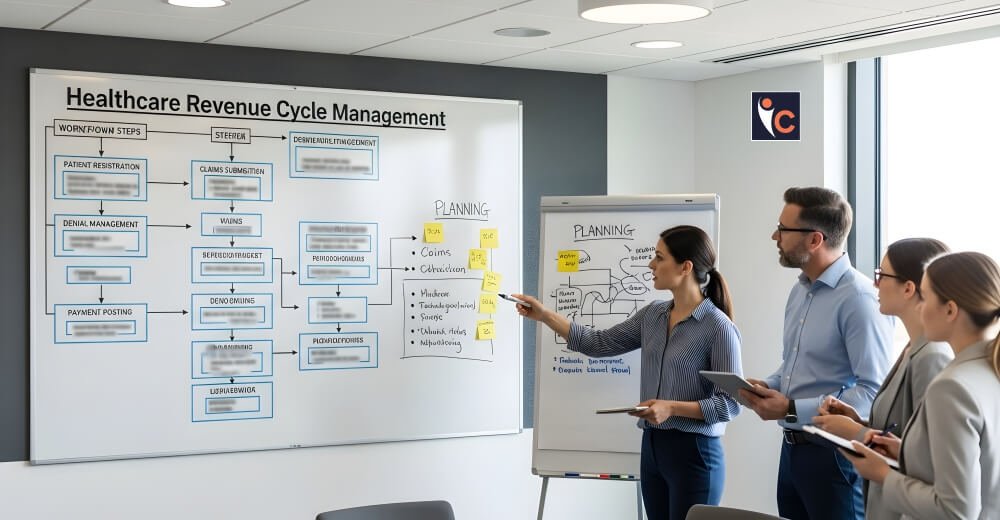Compliance Enhancement
Financial stability and regulatory compliance go hand in hand in today’s fast-changing healthcare landscape. As reimbursement rules grow more complicated and payer scrutiny increases, healthcare organizations must ensure every claim is accurate, timely, and compliant. Intelligent RCM Automation solutions help meet these demands by using advanced technologies and automated workflows that streamline the revenue cycle and strengthen compliance.
This article explains how intelligent RCM Automation helps healthcare organizations overcome revenue cycle challenges by simplifying processes, strengthening compliance, and improving overall financial performance.
Persistent Challenges in RCM and Compliance
Many healthcare organizations still use legacy systems and siloed processes that slow down modernization. These older systems often do not connect well with each other, making it hard to share data or maintain consistent standards throughout the revenue cycle. As a result, automation efforts become limited and less effective.
Organizational complexity adds another layer of difficulty. Revenue cycle operations involve clinicians, billing teams, coding specialists, IT departments, and payers, each working with different requirements and workflows. In the absence of standardized processes, organizations comply with inconsistencies and delays that increase the compliance risk.
Constantly shifting payer policies and regulatory requirements further complicate the landscape. The manual processes can no longer keep up, and one will have wrong submissions, documentation gaps, and increased audit exposure. These issues render intelligent RCM Automation a critical investment for current healthcare organizations.
How Intelligent Automation Solves These Challenges
Intelligent automation platforms offer complete, end-to-end revenue cycle solutions. They integrate all key functions and encompass compliance in daily operations. Such systems not only automate common procedures but can also read documents, use rules, and direct groups to proper outcomes.
- Smarter Patient Registration and Verification
Patient details are registered and verified immediately using automatic systems. Real-time insurance validation eliminates mistakes, causing rejections and provides the revenue cycle with reliable information.
- Accurate and Consistent Coding
Clinical documentation is evaluated using automated coding tools that can code the records with the appropriate codes. This prevents errors, lessens risk in compliance, and enhances the quality of documentation.
- Improved Denial Management
Automation helps categorize denials, identify root causes, and prepare appeals quickly. Integrated models detect patterns in denial trends, enabling teams to correct systemic issues and reduce future noncompliance.
- Embedded Controls of Compliance
The Automation solutions of RCM Modern payer rules and regulatory standards are automatically enforced. The systems refresh the requirements and use them across workflows to avoid errors before claims can be delivered.
- Better Analytics and Oversight
Real-time dashboards give a clear picture of compliance risks, bottlenecks and denial trends. These insights can help leadership teams make changes to processes and minimize vulnerabilities.
How RCM Automation Enhances Compliance
Compliance is the very core that keeps the income safe. The main ways that intelligent automation helps to keep the system safe are by:
- Reduction and Consistency of error
Autonomous operations limit human interactions and eliminate variations. Thus, it is helpful in making sure that every claim is supported by the correct documentation and payers.
- Real-Time Rule Updates
The changes in policies of payers or the regulations are implemented automatically; hence, the chances of submissions being outdated or incorrect are very low.
- Proactive Claim Reviews
Pre-submission audit tools verify claims with missing or erroneous information prior to going out and enhance first-pass acceptance and minimize rework.
- Complete Audit Trails
All the steps in the revenue cycle are captured through automated systems, thereby providing clear and credible audit trails that can be reviewed by the regulatory authorities.
Benefits Beyond Compliance
Intelligent RCM automation does not just offer compliance safeguards. It improves financial performance and efficiency by speeding up accurate claim processing, reducing administrative work, preventing revenue loss, and allowing staff to focus on more complex cases and patient needs instead of routine tasks.
Such real-time knowledge can also facilitate more effective contract negotiations, resource planning, as well as long-term decision-making. Consequently, the whole process of the health system can turn into a source of competitive advantage instead of being just the ordinary routine of the back-office functions.
Conclusion
As healthcare regulations and payer expectations continue to evolve, organizations need modern solutions to maintain strong compliance and financial health. Intelligent RCM Automation strengthens accuracy, enforces up-to-date rules, and provides continuous oversight through automated audits and real-time analytics.
By integrating advanced technologies with compliance-centered workflows, intelligent automation reinforces every component of the revenue cycle. Organizations that embrace these solutions reduce risk, limit errors, and gain the agility needed to thrive in an increasingly complex regulatory environment.





